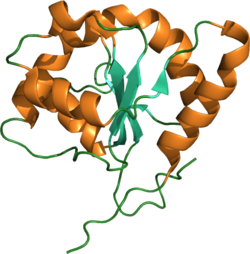Toll-like receptor 1
TLR 1 is a member of the toll-like receptor family (TLR) of pattern recognition receptors of the innate immune system.[5][6] TLR1 recognizes pathogen-associated molecular pattern with a specificity for gram-positive bacteria. TLR1 has also been designated as CD281 (cluster of differentiation 281).
TLRs are highly conserved from Drosophila to humans and share structural and functional similarities. They recognize pathogen-associated molecular patterns (PAMPs) that are expressed on infectious agents, and mediate the production of cytokines necessary for the development of effective immunity. The various TLRs exhibit different patterns of expression. This gene is ubiquitously expressed, and at higher levels than other TLR genes. Different length transcripts presumably resulting from use of alternative polyadenylation site, and/or from alternative splicing, have been noted for this gene.[7]
TLR1 recognizes peptidoglycan and (triacyl) lipopeptides in concert with TLR2 (as a heterodimer).[8][9] Toll-like receptors, including TLR-1, found on the epithelial cell layer that lines the small and large intestine are important players in the management of the gut microbiota and detection of pathogens.[10] It is also found on the surface of macrophages and neutrophils.
Interactions
TLR 1 has been shown to interact with TLR 2.[11]
References
- ^ a b c GRCh38: Ensembl release 89: ENSG00000174125 – Ensembl, May 2017
- ^ a b c GRCm38: Ensembl release 89: ENSMUSG00000044827 – Ensembl, May 2017
- ^ "Human PubMed Reference:". National Center for Biotechnology Information, U.S. National Library of Medicine.
- ^ "Mouse PubMed Reference:". National Center for Biotechnology Information, U.S. National Library of Medicine.
- ^ Rock FL, Hardiman G, Timans JC, Kastelein RA, Bazan JF (January 1998). "A family of human receptors structurally related to Drosophila Toll". Proc. Natl. Acad. Sci. U.S.A. 95 (2): 588–93. Bibcode:1998PNAS...95..588R. doi:10.1073/pnas.95.2.588. PMC 18464. PMID 9435236.
- ^ Lien E, Ingalls RR (January 2002). "Toll-like receptors". Crit. Care Med. 30 (1 Suppl): S1–11. doi:10.1097/00003246-200201001-00001. PMID 11782555.
- ^ "SRF serum response factor". Entrez Gene. National Center for Biotechnology Information, National Institutes of Health.
- ^ Farhat K, Riekenberg S, Heine H, Debarry J, Lang R, Mages J, Buwitt-Beckmann U, Röschmann K, Jung G, Wiesmüller KH, Ulmer AJ (March 2008). "Heterodimerization of TLR2 with TLR1 or TLR6 expands the ligand spectrum but does not lead to differential signaling". J. Leukoc. Biol. 83 (3): 692–701. doi:10.1189/jlb.0807586. PMID 18056480. S2CID 1129471.
- ^ Jin MS, Kim SE, Heo JY, Lee ME, Kim HM, Paik SG, Lee H, Lee JO (September 2007). "Crystal structure of the TLR1-TLR2 heterodimer induced by binding of a tri-acylated lipopeptide". Cell. 130 (6): 1071–82. doi:10.1016/j.cell.2007.09.008. PMID 17889651. S2CID 10992433.
- ^ de Kivit S, Tobin MC, Forsyth CB, Keshavarzian A, Landay AL (2014). "Regulation of Intestinal Immune Responses through TLR Activation: Implications for Pro- and Prebiotics". Frontiers in Immunology. 5: 60. doi:10.3389/fimmu.2014.00060. PMC 3927311. PMID 24600450.
{{cite journal}}: CS1 maint: unflagged free DOI (link) - ^ Takeuchi O, Sato S, Horiuchi T, Hoshino K, Takeda K, Dong Z, Modlin RL, Akira S (Jul 2002). "Cutting edge: role of Toll-like receptor 1 in mediating immune response to microbial lipoproteins". J. Immunol. 169 (1): 10–4. doi:10.4049/jimmunol.169.1.10. PMID 12077222.
External links
- Toll-Like+Receptor+1 at the U.S. National Library of Medicine Medical Subject Headings (MeSH)
- PDBe-KB provides an overview of all the structure information available in the PDB for Human Toll-like receptor 1 (TLR1)
This article incorporates text from the United States National Library of Medicine ([1]), which is in the public domain.







